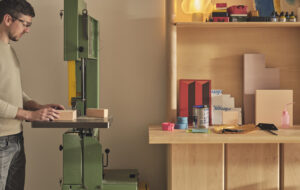
 James Dyson is an extraordinary designer engineer, with a penchant for everyday products.
James Dyson is an extraordinary designer engineer, with a penchant for everyday products.
His bagless vacuum cleaner has become a British design icon, with the new DC24, which employs “ball” technology, threatening to deem vacuums on wheels obsolete. Meanwhile, Dyson’s Airblade hand dryer is becoming increasingly popular with companies, on account of it being efficient, hygienic and green. And the fact that the traditional model is a little slow.
“You just stand there for ages, walk away and wipe your hands on your trousers,” says Dyson of the old models. “That has always been my experience – and I hear most people share that.”
Design should be all about taking onboard real-life scenarios, and creating solutions to them, explains Dyson. “It could be a new shower for the workplace, a sleeping space, or a hand dryer.”
Despite being forced to abandon plans for the Dyson School of Design Innovation, after more than four years of planning, Dyson is still intent on devising new education resources to promote a vocation in engineering to a new generation.
When the UK manufacturing industry gave him the cold shoulder over his cyclone technology vacuum cleaner, Dyson went away and set up his own company to put his design into production.
This “huge cathedral-like factory” in Malmesbury, Wiltshire, is now home to Dyson’s HQ and research and development facility, employing more than 400 engineers.
Of the numerous prototypes cooked up in the Dyson laboratory, an air hangar-like structure designed by Sir Norman Foster, most never make it to production. Such is the nature of invention.
Dyson personally approves, and disproves, ideas. He is dexterous when it comes to recognising flaws – and strengths – in a given proposal.
Each year, Dyson design heads go to graduate shows to scout out product designers and engineers with an eye for solutions. “There is a real buzz about the place when Dyson is around,” a 2007 recruit tells us. It is a shared dream by engineers to have their design commended by the man himself.
Little wonder, when Dyson is now one of the most popular brands in the UK, and with James Dyson’s estimated worth standing at £1bn.
Fortunately, reaching 61, and owning residencies including a chateau in France, does not spell retirement for Dyson. Most of his time is spent on site at the plant in Wiltshire. Inventing, it seems, is a tireless task.
“Just as the first Airblade went into production, we were working on a new prototype,” Dyson explains. It is this strive for perfection that underpins his success
It took five years and more than 5,000 prototypes for him to engineer his bagless vacuum cleaner, which Hoover attempted to rival. A year in court and a $5m payout later established Dyson’s stronghold in the market. It became the fastest-selling vacuum cleaner to be made in the UK.
The Airblade was launched in 2006 and could soon be found in only the most stylish washrooms, including visitor toilets at the London Eye, Natural History Museum and Business Design Centre.
It is now to be found on a more comprehensive scale, often across whole companies. EDF Energy, which was getting through nine million paper towels annually at eight of its sites, despite having conventional dryers, has ordered 165, as part of a pledge to reduce its waste to landfill to zero by 2020.
“The Airblade uses a fifth of the energy of a traditional hand dryer,” says Dyson, as it dries hands in 10 seconds and doesn’t rely on heat. The technology is based on a new digital motor that spins at almost 100,000 revolutions per minute.
“Air is forced through a 0.3mm slot at 400mph creating what we call an ‘air knife’, which literally wipes the water off your hands, like a windscreen wiper.”
The Airblade has just received accreditation from the British Skin Foundation, as a skin-friendly solution to drying. It also cleanses the air, so that people are not drying their hands with “nasty lavatory air”.
“The traditional dryer works by evaporating the water – literally boiling it off your hands,” adds Dyson. “This takes a lot of energy – 2,000 to 2,500 watts – and a lot of time, typically 40 seconds.”
Hand dryers are not the only energy wasters he has identified in the workplace. “Computers consume a huge amount of electricity and emit heat that then has to be cooled,” observes Dyson.
“We have had to have air-con running in winter because our computers let off so much heat. Computers with low power screens without cooling fans must come in soon. We must push for that.
“Also, we should be prepared to be in hotter offices in the summer, and cooler offices in the winter, so you wear T-shirts in summer and jerseys in winter.
“We have just implemented at work that the air- con doesn’t come on until it gets to 27C. This saves 40 per cent of our electricity bill.”
The problem with changing something as ingrained as the traditional office set-up is that “you have got to convince people that something else is better”, Dyson explains.
“I suspect that computers, as we know them, will vanish quite quickly. The latest iPhone, for example, will change what we do in our office. I very rarely look at my laptop now, as I almost prefer using my Blackberry.
“That means I can be with them [the employees] all the time, talking to them, having real discussions. Out of arguments and discussion come creativity. You can do that all the time instead of answering emails, which can you do on the train, on the bus or waiting for the doctor.
“We have got a very big drawing office, with 400 engineers in. It is quite interesting when I look at that. Most people are actually sat around a big glass table talking to each other, discussing things, inventing drawings and prototypes. There are very few people on their own computers.”
In education also, Dyson advocates a prototype-heavy approach to design. “Traditionally, students are taught the academic side of things, and when they have learned enough of that, they go and start experimenting. I think actually you should almost do it the other way around. They should experiment first and discover why they need to know the theory, because then they are driven.
“I have noticed that some of the engineering shows are on the whole quite unimaginative. I think design degree shows, on the whole, are pretty good.
“Just learning the theory of engineering doesn’t necessarily make it very useful; you need to have a creative side as well.”
Dyson may be in a position to bring alive the exciting and innovative world of engineering, but manufacturers need to welcome risk for the market to undergo change.
“As a manufacturer, I think you have to,” says Dyson. “For many years, you have got away without having to do that. But in today’s truly global economy, the only people to survive will be the people who innovate, who lead the markets and who produce products that excite people and that do something better.
“Some people survive by copying or doing it cheaper. The only worthwhile way to carry on is to take risks and to reinvent yourself all the time.”
























